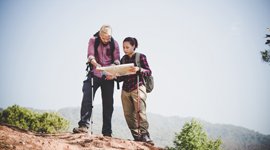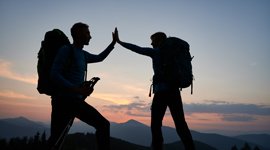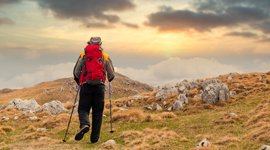
Many trekkers including beginners and experienced have their eyes set on Brahmatal Trek. They are lured in by this 12,500-foot adventure that changes with the seasons. This trek is a natural fit in the Garhwal Himalayas under Chamoli District. The trek’s breathtaking views attract trekkers globally, year after year. It's one of the favorites all thanks to its unique palette of seasonal experiences.
Brahmatal has diverse landscapes ranging from snow-laden paths to lush green meadows. The trek’s height and geographical location contribute to this diverse trek. Weather conditions keep changing here, making it important for trekkers to understand the best time to visit Brahmatal Trek. Trekkers make this decision understanding Brahmatal Trek Weather. The weather you walk on the Brahmatal trail will greatly influence your trek experience.
Brahmatal Trek’s charm isn't only in its breathtaking views, but also in its rich experiences. If you wish for an unforgettable trip, timing is incredibly important. Temperatures vary greatly at Brahmatal Trek; the summers are warm and the winters are chill. Whether you seek the thrill of snow or the beauty of blooming flowers, the right timing makes all the difference.
It's not news that the Brahmatal Trek Best Time is influenced by seasonal changes. The change in temperature and weather conditions affect what you seek. Winter months (December to March) see temperatures drop to as low as -10°C at night. This turns the trek into no less than a snow-covered paradise. Conversely, spring (April to June) offers mild temperatures, ranging between 5°C to 15°C. It allows trekkers to enjoy the trek’s lush greenery and blooming wildflowers.
Some trekkers see Brahmatal trek photos and get excited—their enthusiasm peaks with views of green meadows with no snow. Plan your trek according to the seasons, and allow yourself an experience that aligns with your preferences. If you crave adventure and snow, winter is ideal. However, if vibrant flowers and lush greenery inspire you, spring might be your best bet. Ultimately, time your trek to fit your interests. Your enjoyment and satisfaction will be maximized.
The Brahmatal Trek promises a magical experience with its snow-laden landscapes, panoramic views, and the serene Brahmatal Lake. This trek is not just about reaching a destination; it's about immersing yourself in nature's wonders.
As you hike, you'll encounter various flora and fauna, including Himalayan oak, rhododendrons, and unique wildlife such as the Himalayan black bear and numerous bird species. Each season offers different highlights, from the pristine white snow in winter to the lush meadows filled with colorful flowers in spring.
Standing at 12,250 feet, trekkers are treated to breathtaking scenery that shifts dramatically with the seasons. The daily changes keep the trek engaging, offering plenty of opportunities to enjoy stunning views and connect with fellow adventurers. With captivating Brahmatal trek photos to inspire your journey, each trekker is sure to find something that resonates deeply with their spirit of adventure.
Are you clueless about the different seasons at Brahmatal? Below is a seasonal explanation for you:
Winter (December to March)
Winters are like a magic spell on the Brahmatal Trek, turning it into a snowy paradise. The trail is often blanketed in thick snow. This attracts snow lovers eager for 'the winter' experience.
Temperatures often dip below freezing, reaching as low as -10°C at night. The pristine environment around them only adds to their already good experience.
Winters come with risks and trekkers must be adequately equipped for winter conditions. Layering clothing, sturdy boots, and thermal gear are crucial. With the right preparation, Brahmatal trek in winter is worth it.
Spring (March to April)
With traces of winter around, spring ushers in freshness. The Brahmatal trek weather becomes milder. Temperatures no longer go below sub-zero and range from 5°C to 15°C. If vibrant colors and blooming flowers along the trails are what you need, this is your go-to.
Spring's meadows are free of the uncertainty of the snow. The trails will offer you rhododendrons and wildflowers from time to time. The new start's fresh and crisp air intoxicates and keeps you captive.
Trekkers capture click-worthy photographs as the season offers clear visibility. Mt. Trishul and Mt. Nanda Ghunti stand tall and majestic and offer you their best sight. Thus, spring has both comfort and beauty.
Summer (May to June)
Temperatures see a rise from spring into summer. The daytime highs may reach 25°C to 27°C. A warm weather like this insinuates the need to stay well-hydrated, especially under the sun.
In summer, the meadows turn a yellow-brownish hue. These then turn to green fields by the end of June. Dry weather created a haze despite the clear, panoramic views.
Nights during summer remain relatively cool. The minimum temperatures hover around 15°C. Trekkers may find that visibility decreases slightly as the day progresses in the dry weather. Nonetheless, the clear morning skies are perfect for views of Mt. Trishul and Mt. Nanda Ghunti.
Monsoon (July to September)
Monsoon welcomes heavy rains and mist. The Brahmatal trek then becomes a unique yet risky experience. Trekking in the rain excites some trekkers, but this season is not highly recommended. There is a huge potential for hazards.
The trails can become slippery, which increases the risk of landslides significantly. Heavy rainfall may obscure the views, making it less exciting for many trekkers. Trekkers should be cautious and well-prepared if they choose monsoon. It's not recommended and is a seldom-taken trek.
However, the monsoon has a different kind of beauty. Meadows turn lush green, with greenery in every nook and cranny. Challenging, life-threatening, but beautiful…not worth the risk.
Autumn (October to November)
Autumn is a photographer's dream. It offers clear skies with toppings of post-monsoon beauty. Many trekkers consider this to be the best time for the Brahmatal Trek. Temperatures (12°C to 21°C) are comfortable and views are stunning. What's there to complain about?
The rich colors come alive during monsoon, ready for the perfect picture. If you see Brahmatal Trek photos from this season, you are bound to blurt out—WOW!
Is your Brahmatal Trek your destination? Then you must understand Brahmatal trek temperature and weather patterns.
In winter, temperatures can drop significantly. They often reach as low as -10°C at night. Proper gear and preparation are essential for a winter trek to Brahmatal.
During spring and autumn, temperatures are generally mild, ranging from 5°C to 15°C. This moderate weather allows a comfortable trekking experience. Trekkers enjoy the beauty of their surroundings minus the extreme conditions.
Each season has its different weather patterns. Trekkers who are aware of this can prepare appropriately. If they know the summers are dry, they'll carry extra water to avoid dehydration. A well-informed trekker is always a happy trekker!
Without beating around the bush, here's what you need to know:
Brahmatal Trek Altitude: 12,200 ft
Brahmatal Trek Distance: 24 km (approx.)
Brahmatal Trek Base Village: Lohajung
Brahmatal Trek Days: 4 to 6 days
Brahmatal Trek Quick Itinerary:
Day 1: Rishikesh to Lohajung (10 to 11 hrs drive)
Day 2: Lohajung to Bekaltal Campsite (6 km trek)
Day 3: Bekaltal to Brahmatal (8 km trek)
Day 4: Brahmatal to Summit and back to Lohajung (9 to 10 km trek)
Day 5: Lohajung to Rishikesh (10 to 11 hrs drive)
For more details about the trek days, check our Brahmatal Trek Itinerary.
Two key attractions come along the Brahmatal Trek: the majestic Mt. Trishul (7,120 m) and the tranquil Brahmatal Lake (3,600 m). Each season, trekkers see them in a different light. The panorama of mountain views shapeshifts every season and trekkes are left awe-struck.
In winter, the surrounding peaks glisten with snow. The views of Mt. Trishul and Mt. Nanda Ghunti, stun the viewers. Spring comes with vibrant flowers and lush green meadows. These natural colors paint the Brahmatal trek in a new light. Autumn brings the rich hues of changing foliage. The retired leaves make a carpet for trekkers to walk on. It’s all picture-perfect, enough to capture life-like Brahmatal trek photos.
Every corner of the trek presents new sights and experiences. It has Bekaltal Lake, Tilandi Top, Jhandi Top, a view of the Roopkund trail, and much more. The trek can keep every trekker abound with its various specialties.
The Best Time for Brahmatal Trek: Your Preferences This Time!
Brahmatal trek can hardly be summed into countable preferences. But, here are some popular ones:
For Snow Lovers
Brahmatal Trek is the ultimate choice for winter trekking. The call of a snowy landscape is hard to miss for someone who appreciates snow.
Did you choose a winter trek to Brahmatal? Then come prepared for freezing temperatures. Wear at least 5 layers and keep yourself warm and comfortable.
For Nature Lovers and Photographers
Spring and autumn shine as the most vibrant seasons. Their moderate temperatures and stunning landscapes offer excellent opportunities for photography and appreciation of nature’s beauty.
Your personal preferences should align with your trek timing for a lifetime memory. Every season comes with a give and take, it's your choice: What are you willing to give for you to take something?
Planning A Brahmatal Trek? Here Are Some Pro Tips!
Keep these pro tips in mind and you are good to go:
Follow these tips for a better trekking experience, even your best one to date.
Final Thoughts on the Best Time for Brahmatal Trek!
To summarize, the best time to trek Brahmatal largely depends on your personal preferences. Timing is only as relevant as the experiences you seek.
For someone who loves snow, winter is the obvious choice. The white-capped peaks you are surrounded by are unparalleled.
For someone who loves nature and its vibrance, blooming flowers, and clear skies attract them. So, it's ideal that nature lovers and photographers choose spring or autumn.
Every trekker has a reason to choose one season and leave the other. One thing is constant: the beauty of the Brahmatal trek.



